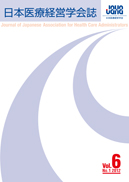Volume 9, Issue 1
Displaying 1-8 of 8 articles from this issue
- |<
- <
- 1
- >
- >|
Opening Article
-
2015 Volume 9 Issue 1 Pages 3
Published: 2015
Released on J-STAGE: March 10, 2016
Download PDF (604K)
Original Articles
-
2015 Volume 9 Issue 1 Pages 5-11
Published: 2015
Released on J-STAGE: March 10, 2016
Download PDF (1772K) -
2015 Volume 9 Issue 1 Pages 13-19
Published: 2015
Released on J-STAGE: March 10, 2016
Download PDF (4561K) -
2015 Volume 9 Issue 1 Pages 21-28
Published: 2015
Released on J-STAGE: March 10, 2016
Download PDF (1498K) -
2015 Volume 9 Issue 1 Pages 29-37
Published: 2015
Released on J-STAGE: March 10, 2016
Download PDF (2351K)
Review Article
-
2015 Volume 9 Issue 1 Pages 39-45
Published: 2015
Released on J-STAGE: March 10, 2016
Download PDF (1355K) -
2015 Volume 9 Issue 1 Pages 47-56
Published: 2015
Released on J-STAGE: March 10, 2016
Download PDF (1078K)
Research Paper
-
2015 Volume 9 Issue 1 Pages 57-63
Published: 2015
Released on J-STAGE: March 10, 2016
Download PDF (2079K)
- |<
- <
- 1
- >
- >|
